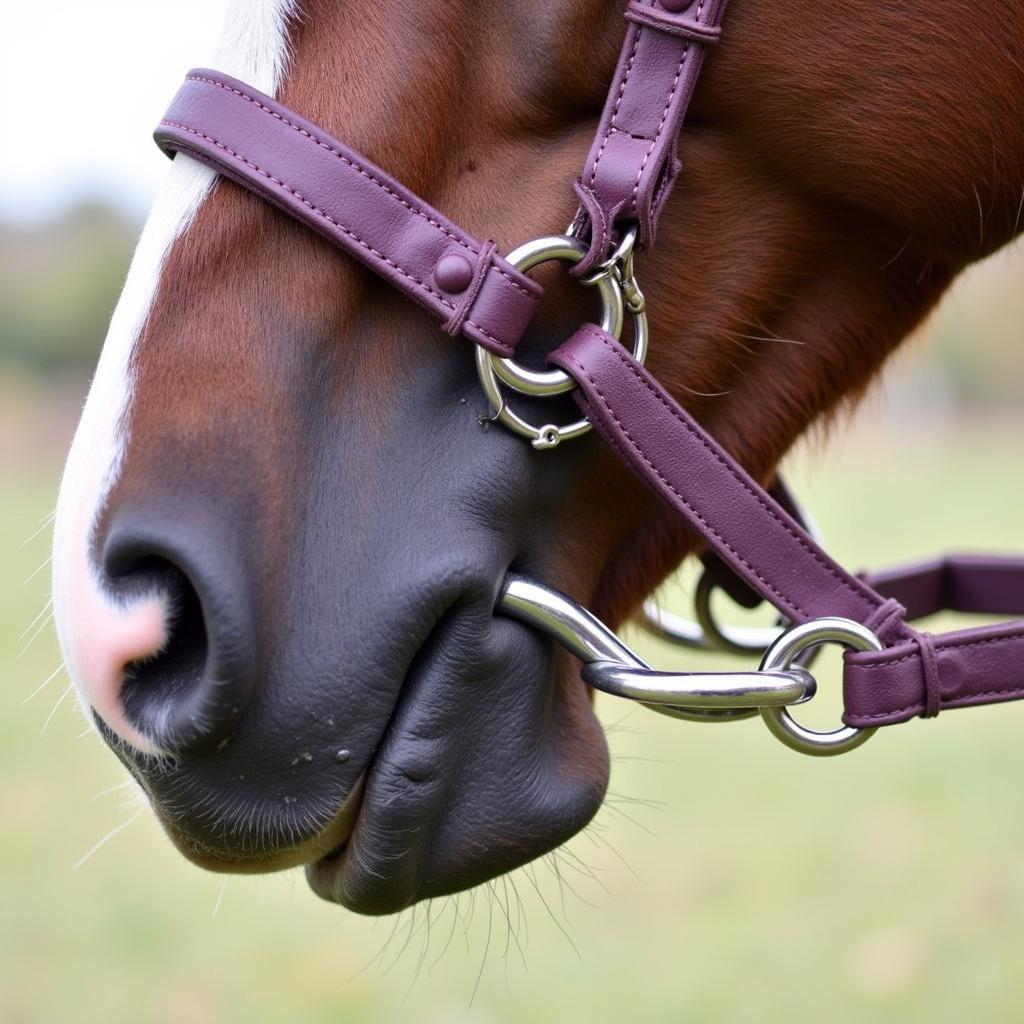A Curb Chain For Horses is a key component of a curb bit, a type of leverage bit used in riding. It applies pressure to the horse’s chin groove and poll, offering more control than a snaffle bit. Understanding its function is crucial for responsible horsemanship. Let’s delve into the details of curb chains, exploring their types, proper usage, and potential pitfalls.
What is a Curb Chain for Horses?
Curb chains are typically made of metal, sometimes covered with leather or rubber for added comfort. They work in conjunction with curb bits to exert leverage on the horse’s head. When the reins are engaged, the curb bit rotates, and the shanks of the bit pull on the curb chain. This pressure is applied to the chin groove, poll, and bars of the horse’s mouth, encouraging a specific head position and response to rein aids. The action of the curb chain differs significantly from a pelham bits for horses, which combines the actions of both snaffle and curb.
 Horse Wearing a Curb Chain
Horse Wearing a Curb Chain
Types of Curb Chains
Various types of curb chains cater to different needs and horse sensitivities. Some common types include:
- Flat Link Chain: A standard option, offering moderate control.
- Cable Chain: Smoother than flat link chains, providing a more refined pressure.
- Leather Curb Strap: A gentler option for sensitive horses, distributing pressure over a wider area.
- Rubber Curb Strap: Provides cushioned pressure, often preferred for horses with delicate skin.
Choosing the appropriate curb chain is vital for horse comfort and effective communication. Consider your horse’s individual needs, experience level, and sensitivity. For more information on the different types of horse restraints, see our article on horse chain.
Proper Adjustment and Usage of Curb Chains
Proper adjustment of the curb chain is paramount for its effectiveness and the horse’s well-being. A too-loose chain renders the curb bit ineffective, while a too-tight chain can cause discomfort and even pain.
How to Adjust a Curb Chain
The general rule is that you should be able to fit two fingers between the curb chain and the horse’s chin groove. This allows for enough slack so the chain doesn’t constantly apply pressure, but is engaged when the reins are used. Over-tightening can lead to resistance, head tossing, and even injury.
Common Mistakes with Curb Chains
Using a curb chain incorrectly can lead to various problems. Some frequent mistakes include:
- Over-tightening: Causes discomfort and resistance, negating the benefits of the curb bit.
- Using a Curb Bit with a Snaffle Rein: This setup can create confusing and inconsistent signals for the horse.
- Ignoring Signs of Discomfort: Pay attention to your horse’s behavior; head tossing, gaping mouth, and resistance can indicate a problem with the curb chain.
“A properly adjusted curb chain is an effective tool for refined communication with your horse,” says renowned equine trainer, Sarah Mitchell, “But misuse can easily turn it into a source of discomfort and confusion.”
When to Use a Curb Chain?
Curb chains are typically used in western riding disciplines, certain English riding styles, and for driving. They offer enhanced control and precision, aiding in maneuvers like sliding stops, spins, and collection. However, they’re not suitable for all horses or riders. Beginners should seek guidance from experienced trainers before using a curb bit and chain. Are you interested in learning more about different types of bits? Check out our resource on bit horses.
Conclusion
The curb chain for horses, when used correctly, can be a valuable tool for enhancing communication and control. Understanding its function, proper adjustment, and potential pitfalls is crucial for responsible horsemanship. By prioritizing horse comfort and seeking expert guidance when needed, riders can harness the benefits of the curb chain while ensuring their horse’s well-being. Remember, a correctly fitted curb strap horse is essential for a comfortable ride. For more specific information regarding chain bits, please visit our article on chain bit for horses.
FAQ
- What’s the difference between a curb chain and a curb strap?
- Can I use a curb chain with any type of bit?
- How do I know if my curb chain is too tight?
- What are the alternatives to a curb chain?
- What disciplines typically use curb chains?
- Can I use a curb chain on a young horse?
- How do I clean and maintain my curb chain?
For further assistance, contact us at Phone Number: 0772127271, Email: [email protected] or visit us at QGM2+WX2, Vị Trung, Vị Thuỷ, Hậu Giang, Việt Nam. We have a 24/7 customer service team ready to help.